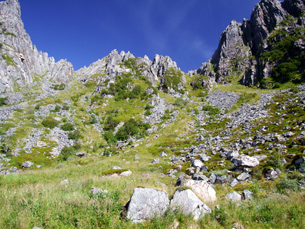Module 8
1. Module 8
1.28. Page 2
Module 8—Populations, Individuals, and Gene Pools
 Explore
Explore

© Marek Slusarczyk/1416110/Fotolia
The changes that a community goes through as it ages are known as succession. For every biome, or microclimate within a biome, there is a predictable, ordered, succession of plant and animal species that will play their parts and then disappear. This is a process that begins with the first pioneer species that invades the soil or rock and continues to the final, stable climax species that represents the completed succession.
Communities are named for their climax species of plant life (e.g., aspen forest or black spruce forest). The photo depicts primary succession after a rockslide destroyed all life in the area. The slow process of making soil through freeze-thaw fracture has allowed the pioneer species of lichens to be replaced with mosses and small plants. This process will eventually result in the rockslide area being returned to the original spruce forest. A secondary succession (e.g., after the clear-cutting of a forest) in this same area would take much less time because the succession would begin from soil and small organisms, rather than rock.
succession: the orderly replacement of one species with another over time; occurs after a disruption, such as fire
pioneer species: the first species of plant to invade a cleared site in a succession
climax species: the last species of plant in the succession; is used to name the succession
primary succession: a succession that begins with bare rock; soil-building organisms (e.g., lichen) are pioneers
secondary succession: a succession that begins with soil
When the producer species change during a succession, the animal species change along with it. In the “Get Focused” section, the grasslands of the prairie would support herbivores (like bison, seed-eaters like mice and gophers) and predators (like hawks and coyotes). If the fires of spring no longer occurred and an aspen forest secondary succession proceeded, bush-browsers and berry-eaters like rabbits, white-tailed deer, and black bear would replace the animals seen early in the succession.
If you were living off the land and needed to hunt or gather to stay alive, would you know what animals are found in which landscapes? This practical knowledge about which animal species go along with which plant species and where to find them is firmly rooted in the traditional knowledge of First Nations peoples.
 Read
Read
To understand the characteristics and types of succession with interesting examples, read “Succession: Community Change over Time” on pages 725 to 726 and page 728 in the textbook. You may find that a chart with terms, definitions, and examples is the best way to summarize this information for your course folder.
 Watch and Listen
Watch and Listen
For scientists, succession is a challenging phenomenon to study because most succession takes longer than a human lifetime to complete. To understand the characteristics of succession, watch “Succession: Communities in Transition.” The following sections are of particular significance to your study:
- “Bio Probe: Succession in Study Area 1”
- “Biotic versus Abiotic Factors”
- “Bio Bit: Succession”
- “Model of Succession”
- “Change in Communities”
- “Bio Fact: Disturbed Areas”
- “Factors Affecting Succession”
- “Fire as an Agent of Change”
As you view the video, consider the following questions:
- Why do successions occur?
- Why are the earlier species replaced rather than added to by other species?
- Why are the species involved in one succession different than those found in another?
You may wish to supplement the work in your course folder based on the video.
 Module 8: Lesson 7 Assignment
Module 8: Lesson 7 Assignment
Part 1 of your assignment involves research into clear-cutting versus selective logging practices. Clear-cutting invovles the random removal of vegetation using large machinery. This practice has major consequences for succession, control of runoff, and the disappearance of wildlife associated with the climax forest. Selective logging is more time-consuming and invovles the selection of specific trees to be harvested.
Retrieve your copy of the Module 8: Lesson 7 assignment that you saved to your computer earlier in the lesson. Complete Part 1 and save it to your course folder.
 Try This
Try This
To review the types and conditions of succession, complete the following table for your course folder.
As plant species change during a succession, so do the species of animals that live off these producers. With each new producer that appears, new herbivores and carnivores migrate into the area to take advantage of the food source. For example, after a fire, the pioneer species of grass favours seed eaters like mice, gophers, and the hawks that eat them. But, when small shrubs start to appear, browsers like rabbits are likely to replace the mice, gophers, and hawks. This is a typical example of succession in central Alberta.
Complete the chart below by adding the related consumer examples to the stages of succession. This first row has been completed for you. If you need ideas about possible consumers, conduct an Internet search using search phrases such as “Alberta food chains” or “Alberta successions.” Add the chart to your course folder.
| Producer Succession | Consumer Succession |
|---|---|
Grass (pioneer species) |
mice/gophers/hawks |
Low shrubs and berries |
|
High shrubs |
|
Aspen poplar trees (climax community) |
|